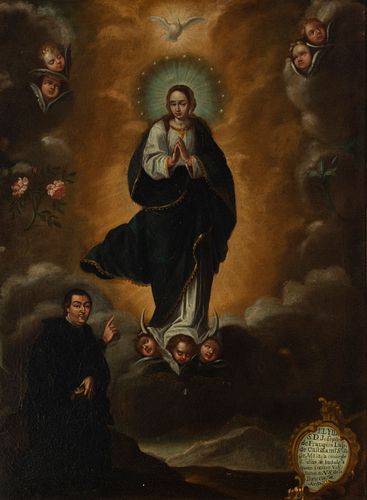Andalusian School, ca.1760. "Immaculate Conception with donor D. Francisco Lasso de Castilla, Bishop of Malaga". Oil on canvas.
Lot 19
About Seller
Setdart Auction House
Carrer Aragó 346
Barcelona
Spain
Setdart Subastas was born in 2004 and is currently the first online art auction in Spain with solidity, prestige and reliability guaranteed by our more than 60,000 users. Setdart has a young, dynamic and enterprising team ready to successfully manage the purchase and sale of art works through custom...Read more
Estimate:
EUR€2,800 - EUR€3,000
$2,916.67 - $3,125
Absentee vs Live bid
Two ways to bid:
- Leave a max absentee bid and the platform will bid on your behalf up to your maximum bid during the live auction.
- Bid live during the auction and your bids will be submitted real-time to the auctioneer.
Bid Increments
| Price | Bid Increment |
|---|---|
| EUR€0 | EUR€10 |
| EUR€200 | EUR€25 |
| EUR€500 | EUR€50 |
| EUR€1,000 | EUR€100 |
| EUR€3,000 | EUR€200 |
| EUR€5,000 | EUR€500 |
| EUR€10,000 | EUR€1,000 |
| EUR€20,000 | EUR€2,000 |
| EUR€50,000 | EUR€5,000 |
About Auction
By Setdart Auction House
Oct 20, 2021
Set Reminder
2021-10-20 07:30:00
2021-10-20 07:30:00
America/New_York
Bidsquare
Bidsquare : OLD MASTERS
https://www.bidsquare.com/auctions/setdart-auction-house/old-masters-7700
Setdart Auction House sofia@setdart.com
Setdart Auction House sofia@setdart.com
- Lot Description
Andalusian School, ca.1760. "Immaculate Conception with donor D. Francisco Lasso de Castilla, Bishop of Malaga". Oil on canvas. With period frame. Measures: 63.5 x 47.5 cm; 69.5 x 57.5 cm (frame). The theme of the Immaculate Conception, very frequent in the Spanish art of the XVII century, came to constitute one of the signs of national identity of Spain as a catholic country. It is one of the most genuinely local themes of Spanish Baroque painting, since our country was the main defender of this mystery, and the one that fought most insistently to make it a dogma of faith. In this context, numerous artists and intellectuals worked to build a clear iconography that would help spread the Immaculate Conception, bringing together symbolism and popular fervor. Due to its stylistic characteristics, the work in question can be inscribed within the Andalusian school of the late second half of the eighteenth century. It is a direct heir to the Baroque models of Bartolomé Esteban Murillo, both in composition and iconography. Thus, we see Mary dressed in a white tunic, wearing a blue mantle that floats around her. The figures of the child angels also derive directly from Murillo's models, both in their conception and in their placement, distributed between the lower area of the painting, under the pedestal of clouds, and the upper one, as cherub heads surrounding the breaking of Glory. As we have already pointed out, the composition faithfully follows Murillo's models: Mary full-length in the center, dressed in white and blue, with her hair loose forming soft undulations, with the crescent moon at her feet, surrounded by angels and clouds, with the open sky behind her figure, flooded by the golden light of the Gloria. The scene is completed by the presence of a kneeling donor in the lower right corner, in a praying position, looking directly at Christ. It is D. Francisco Lasso de Castilla, Bishop of Malaga, according to the inscription in the lower right part.
- Shipping Info
-
In-house shipping available. Please inquire at admin@setdart.com.
-
- Buyer's Premium



 EUR
EUR CAD
CAD AUD
AUD GBP
GBP MXN
MXN HKD
HKD CNY
CNY MYR
MYR SEK
SEK SGD
SGD CHF
CHF THB
THB






